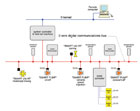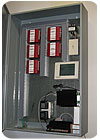
For decades, the residential and light commercial sector of the hydronics industry has used stand-alone controllers designed for very specific purposes. These devices include boiler reset, boiler staging, mixing and zoning controllers.
When used in a typical custom residential system, these individual "boxes"

Figure 1
Lines of Communication
New methods for controlling hydronic systems hold the potential to greatly reduce installation and final adjustment procedures. A new generation of communicating control products is arriving that will allow heating technicians to monitor and adjust the system operation from a remote location using one or more types of digital communication.This is no surprise to those who have worked with larger commercial or institutional HVAC systems the last few years. Direct Digital Control (DDC) systems now allow the authorized staff to view and adjust hundreds of system-operating parameters from a PC, either on- or off-site. In many cases, these systems control lighting, fire protection, elevators and access systems, as well as the HVAC system. Advances in digital technology have made it possible, both technically and economically, to scale DDC concepts down to smaller commercial and residential applications.
Communication between controllers, sensors and controlled devices is the key difference between the past and future of HVAC controls.
The concept of communicating control devices is shown in Figure 1.
The red horizontal line in Figure 1 represents a communication "bus."

Figure 2. Photo courtesy of Innovex Technologies.
Although there are limits on distances between communicating devices, they are typically large enough to accommodate most building needs (several hundred feet between devices). As far as communication is concerned, the physical location of a given device is usually irrelevant; it's the digital address that counts.
When a new device is attached to the bus, the system controller automatically detects it and assigns it the necessary address for communications. It's akin to how we can now "hot swap"
Speaking the Language
The communication "protocols"
Figure 3
What's Going On?
The ability to "query"
Figure 4. Graphic courtesy of Innovex Technologies.
The years ahead will see increasing use of internet-accessible control systems in residential and light commercial hydronic systems. In many cases, this functionality will be part of a larger building automation system, controlling lights, security and other HVAC subsystems. Such systems hold tremendous potential for monitoring system operations, simplifying service and expanding control versatility, while at the same time reducing complexity. Get ready for long-distance chats with your control systems.
